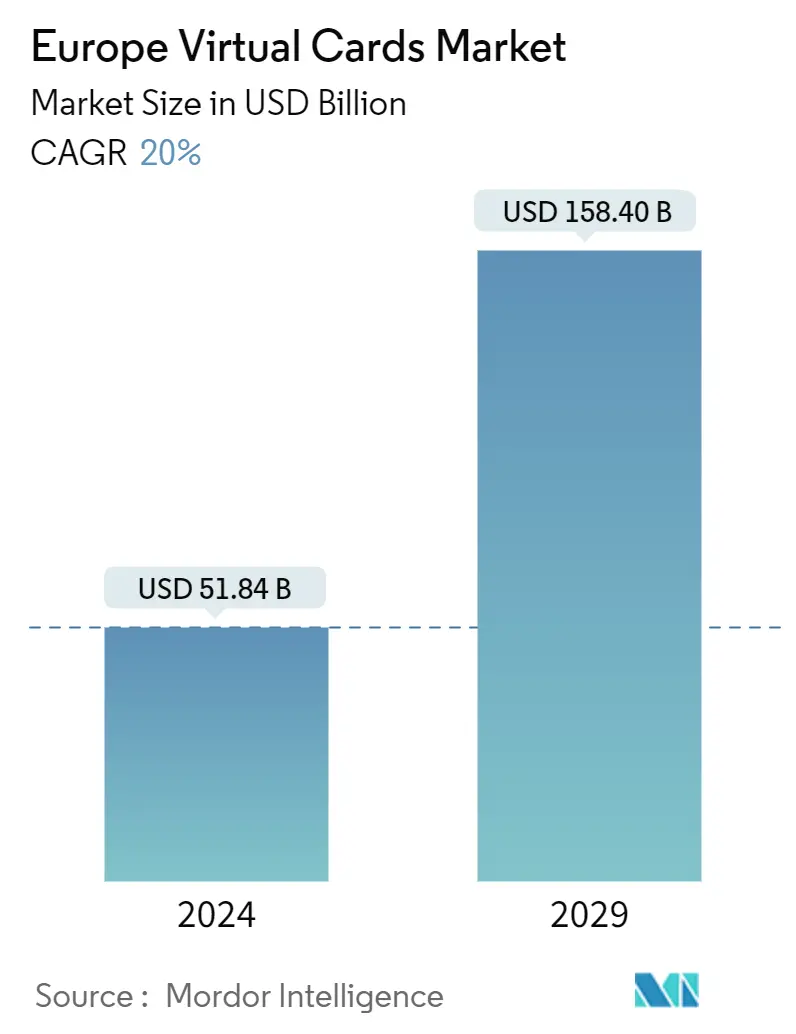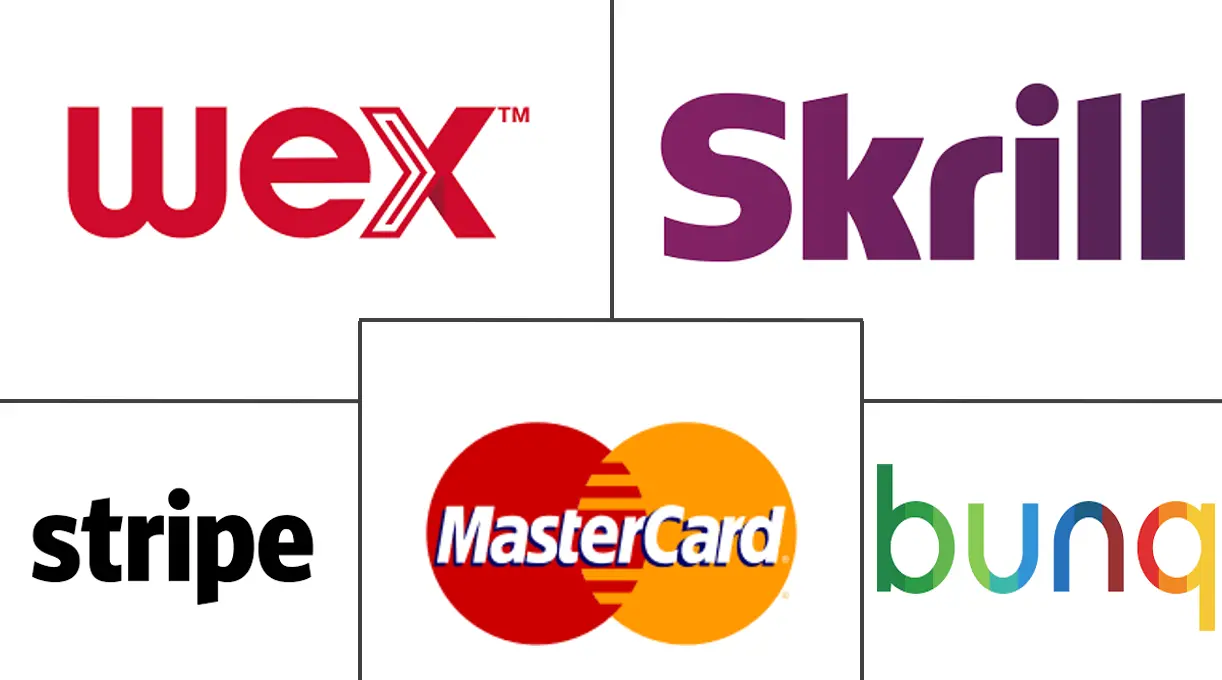Market Size of Europe Virtual Cards Industry

| Study Period | 2020-2029 |
| Base Year For Estimation | 2023 |
| Market Size (2024) | USD 51.84 Billion |
| Market Size (2029) | USD 158.40 Billion |
| CAGR (2024 - 2029) | 20.00 % |
| Market Concentration | Medium |
Major Players
*Disclaimer: Major Players sorted in no particular order |
Europe Virtual Cards Market Analysis
The Europe Virtual Cards Market size is estimated at USD 51.84 billion in 2024, and is expected to reach USD 158.40 billion by 2029, growing at a CAGR of 20% during the forecast period (2024-2029).
The value of Digital transactions has observed a continuous increase over the years rising to more than USD 1.5 Trillion last year and with this increasing amount of digital transaction risk of cyber fraud has also observed a continuous increase in Europe. As a solution to this banks have come up with virtual cards through which a user can make a certain amount of transaction at a time. A specific virtual card can be produced for each transaction with a unique Card number, and credential which differentiate it from the original card the user is holding.
Denmark, Sweden, and the United Kingdom are among the countries in Europe leading in instant payment methods and provide opportunities for banks and financial institutions to expand virtual card payment systems which reduces the level of risk in digital transaction and increase the adoption of transaction-specific virtual cards. With the rising trend of digital payments, Europe's debit card base is observing a y-o-y growth of around 5.5% with a penetration of 1.31 debit cards per capita. This trend is expected to drive the market of virtual cards in the region as an orginal debit card is a precondition condition for having a virtual debit card issued by the bank.
Post Covid, as global businesses are recovering combined with an increase in cyber attacks virtual cards are providing merchants with a more secure way of doing transactions. Instead of using physical cards or checks, virtual cards offer high transaction volume that can be created and used instantly by businesses. With rising e-commerce in Europe, players such as Alibaba, Amazon, and Apple, others have started accepting virtual debit or credit cards, increasing the number of virtual cards issued by the banks. These trends combined with a rising digital payment industry in Europe are creating opportunities for the expansion of Virtual cards in the region.
Europe Virtual Cards Industry Segmentation
A virtual card is a digital card and has features similar to physical bank cards, it is stored in a digital wallet on a phone and can be used to pay contactless in stores or online. It is secured by encryption and has its own unique card number, expiry date, and cvc.
The European virtual cards market is segmented by product type, by end-user, and by country. By product type, the market is segmented into b2b virtual cards, b2c remote payments virtual cards, and b2c poc virtual cards. By end-user, the market is segmented into consumer use and business use. By country, the market is segmented into the United Kingdom, Germany, Switzerland, France, Italy, Spain, and the rest of Europe. The report offers market sizes and forecasts for the European virtual card market in value (USD) for all the above segments.
| By Product type | |
| B2B Virtual cards | |
| B2C Remote Payments Virtual Cards | |
| B2C POC Virtual Cards |
| By End-user | |
| Consumer use | |
| Business use |
| By Country | |
| United Kingdom | |
| Germany | |
| Switzerland | |
| France | |
| Italy | |
| Spain | |
| Rest of Europe |
Europe Virtual Cards Market Size Summary
The European virtual cards market is poised for significant growth, driven by the increasing volume of digital transactions and the rising need for secure payment methods. As digital payments continue to expand, the risk of cyber fraud has also escalated, prompting banks to introduce virtual cards. These cards offer a unique solution by generating a specific card number and credentials for each transaction, enhancing security. Countries like Denmark, Sweden, and the United Kingdom are at the forefront of adopting instant payment methods, providing a conducive environment for the expansion of virtual card systems. The trend towards cashless payments is gaining momentum, with a notable increase in the use of debit cards and contactless payment methods, further propelling the virtual card market in the region.
The post-pandemic recovery has seen a surge in e-commerce and digital payment methods, with major players like Alibaba, Amazon, and Apple accepting virtual cards. This shift is supported by the growing acceptance of virtual debit and credit cards, which offer businesses a secure and efficient way to handle transactions. The United Kingdom, as a leading e-commerce market, is witnessing a rise in digital transactions, encouraging the adoption of virtual card payment methods. The market is characterized by technological advancements and strategic partnerships among key players such as Skrill, Mastercard, and Stripe, aiming to enhance the security and efficiency of digital payments. Recent developments, including Lloyds Bank's partnership with Visa and Wallester's collaboration with Transferra, highlight the ongoing efforts to expand and secure virtual card offerings in Europe.
Europe Virtual Cards Market Size - Table of Contents
-
1. MARKET DYNAMICS AND INSIGHTS
-
1.1 Market Overview
-
1.2 Market Drivers
-
1.2.1 Rising in Adoption of Digital Payment Method
-
1.2.2 Increase in Adoption of Virtual Card Payments by E-Commerce Business
-
-
1.3 Market Restraints
-
1.3.1 Lack in Adoption of Digital Payments by Old Age Group
-
-
1.4 Market Opportunities
-
1.4.1 Innovations for Building Secured Payment Methods
-
-
1.5 Industry Attractiveness - Porters' Five Forces Analysis
-
1.5.1 Threat of New Entrants
-
1.5.2 Bargaining Power of Buyers
-
1.5.3 Bargaining Power of Suppliers
-
1.5.4 Threat of Substitutes
-
1.5.5 Intensity of Competitive Rivalry
-
-
1.6 Technological Innovations in the Europe Virtual Card Market
-
1.7 Impact of COVID-19 on the Market
-
-
2. MARKET SEGMENTATION
-
2.1 By Product type
-
2.1.1 B2B Virtual cards
-
2.1.2 B2C Remote Payments Virtual Cards
-
2.1.3 B2C POC Virtual Cards
-
-
2.2 By End-user
-
2.2.1 Consumer use
-
2.2.2 Business use
-
-
2.3 By Country
-
2.3.1 United Kingdom
-
2.3.2 Germany
-
2.3.3 Switzerland
-
2.3.4 France
-
2.3.5 Italy
-
2.3.6 Spain
-
2.3.7 Rest of Europe
-
-
Europe Virtual Cards Market Size FAQs
How big is the Europe Virtual Cards Market?
The Europe Virtual Cards Market size is expected to reach USD 51.84 billion in 2024 and grow at a CAGR of 20% to reach USD 158.40 billion by 2029.
What is the current Europe Virtual Cards Market size?
In 2024, the Europe Virtual Cards Market size is expected to reach USD 51.84 billion.

